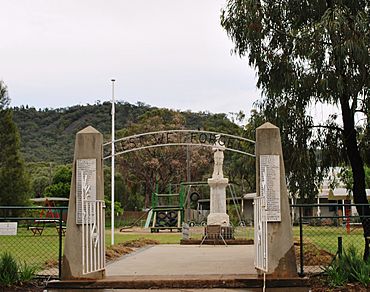Tambar Springs, New South Wales facts for kids
Quick facts for kids Tambar SpringsNew South Wales |
|
|---|---|

War memorial, claimed to be the first World War I memorial in New South Wales
|
|
| Population | 187 (2016 census) |
| Postcode(s) | 2381 |
| Location | |
| LGA(s) | Gunnedah Shire Council |
| State electorate(s) | Tamworth |
| Federal Division(s) | Parkes, New England |
Tambar Springs is a small town in the North West Slopes area of New South Wales, Australia. This region is known for its rolling hills and farming land. In 2016, Tambar Springs and the nearby areas had a population of 187 people.
Contents
Where is Tambar Springs?
Tambar Springs is part of the Gunnedah Shire Council area. This is a local government area, like a county or district. The town is about 417 kilometres (259 miles) north-west of Sydney, which is the capital city of New South Wales.
A Look at Tambar Springs History
Tambar Springs was first used for grazing animals like sheep and cattle in the 1830s. This means large areas of land were used for feeding livestock. Later, in 1868, more people started to settle there. This was called "closer settlement." The village officially became a town in 1888.
Tambar Springs War Memorial
A special war memorial was built in Tambar Springs in December 1918. It cost about 400 Australian pounds at that time. Many people believe this was the very first memorial built in New South Wales to remember soldiers from World War I.
Tambar Springs is also known for something unique. It had the highest number of men join the Australian Army, compared to its population size. This was true for both World War I and World War II. This means a lot of people from the town volunteered to serve their country.
Amazing Fossils Found Here
Near Tambar Springs, there is an important place where scientists find fossils. This site has many fossils from the Pleistocene period. This was a time long ago, often called the Ice Age.
Discovering Ancient Animals
Between 1979 and 1984, scientists from the Australian Museum worked at this site. They dug up a complete skeleton of a Diprotodon. This was a giant, ancient animal that looked a bit like a huge wombat. They also found parts of another Diprotodon, including its hip bone (pelvis) and thigh bone (femur). These finds help us learn about the animals that lived in Australia a very long time ago.
Images for kids
-
Catholic Church







